Special Report
Great Cities That Came Back After Being Nearly Destroyed

Published:

The COVID-19 pandemic has had a devastating impact on New York City, where almost one in eight deaths from the virus in the United States has occurred. There are reports of residents fleeing New York, convinced that the pandemic, along with the civil disturbances and the high cost of living make the city unlivable. New York has been through adversity before — the HIV/AIDS epidemic, Superstorm Sandy, and of course 9/11 — and it is one of the most resilient cities in the world.
As the future of New York City, as well as other places, is tested by the pandemic, 24/7 Tempo has compiled a list of great cities that came back from tragedy. We compiled our list by reviewing various sources such as britannica.com, warhistoryonline.com, weather.gov and exercised editorial discretion to create the list.
Click here to see great cities that came back from tragedy
Some of the cities on our list date back about 2,500 years, and though they don’t necessarily have the same stature as they once did, they’ve managed to stay relevant in modern time. These cities managed to avoid the fate of cities such as Pompeii, Carthage, Ephesus, Angkor, Palenque, and Petra, all of which disappeared hundreds of years ago. They, along with these 23 countries, no longer exist.
Many other cities persevered, overcoming wars, plagues, fires, earthquakes, hurricanes, and terror attacks. The destruction from events such as the Battle of Stalingrad in 1942-43 and the San Francisco Earthquake in 1906 raised the question at the time as to whether those cities should rebuild at all. In both cases they chose to do so. Tragic episodes such as the Great London Fire in 1666 and the cholera outbreak in Paris in 1832 served to create overdue building and public health improvements that put the cities on the path to modernity.
Methodology
To find great cities that came back from tragedy, 24/7 Tempo reviewed various sources such as britiannica.com, warhistoryonline.com, culturetrip.com, weather.gov and exercised editorial discretion to compile the list. We are not attempting to compile a comprehensive list of cities that have rebounded from adversity. We chose these cities because these are the most famous examples of resilience in the face of catastrophe. We considered but did not include New Orleans because it is still struggling to overcome the devastation of Hurricane Katrina in 2005.

Athens, Greece
> Tragedy: Plague
> When it happened: 430 BC
> Population at the time: 400,000
The golden age of Athens came to an end beginning in 430 B.C., when a plague struck the city while it was under siege from rival city-state Sparta. The epidemic began in early May and lasted as long as five years, killing up to 25% of the city’s population.
Though Athens never returned to the prominence of its golden age, the cradle of democracy is one of the world’s leading tourist destinations.
[in-text-ad]

Rome, Italy
> Tragedy: Sacking by barbarian tribes
> When it happened: AD 410
> Population at the time: 800,000
Perhaps few cities have seen more tragedy than Rome, but its nickname the “Eternal City” seems very fitting. Rome was besieged several times, most famously in A.D. 410, when barbarian tribes burned down Rome, went on a murder spree for three days, and emptied the city’s coffers. With few means to support the army, more invasions followed. Meanwhile, as trade was disrupted, unemployment and distrust of the government rose — all of which contributed to the fall of Rome.
Today, Rome, the capital of Italy, is the center of banking, insurance, publishing, and fashion in the country. The city is a major economic power in Europe in part because of its tourist industry and entertainment production. Rome is home to “Hollywood on the Tiber” — Cinecittà Studios, the largest film and movie studio in continental Europe.
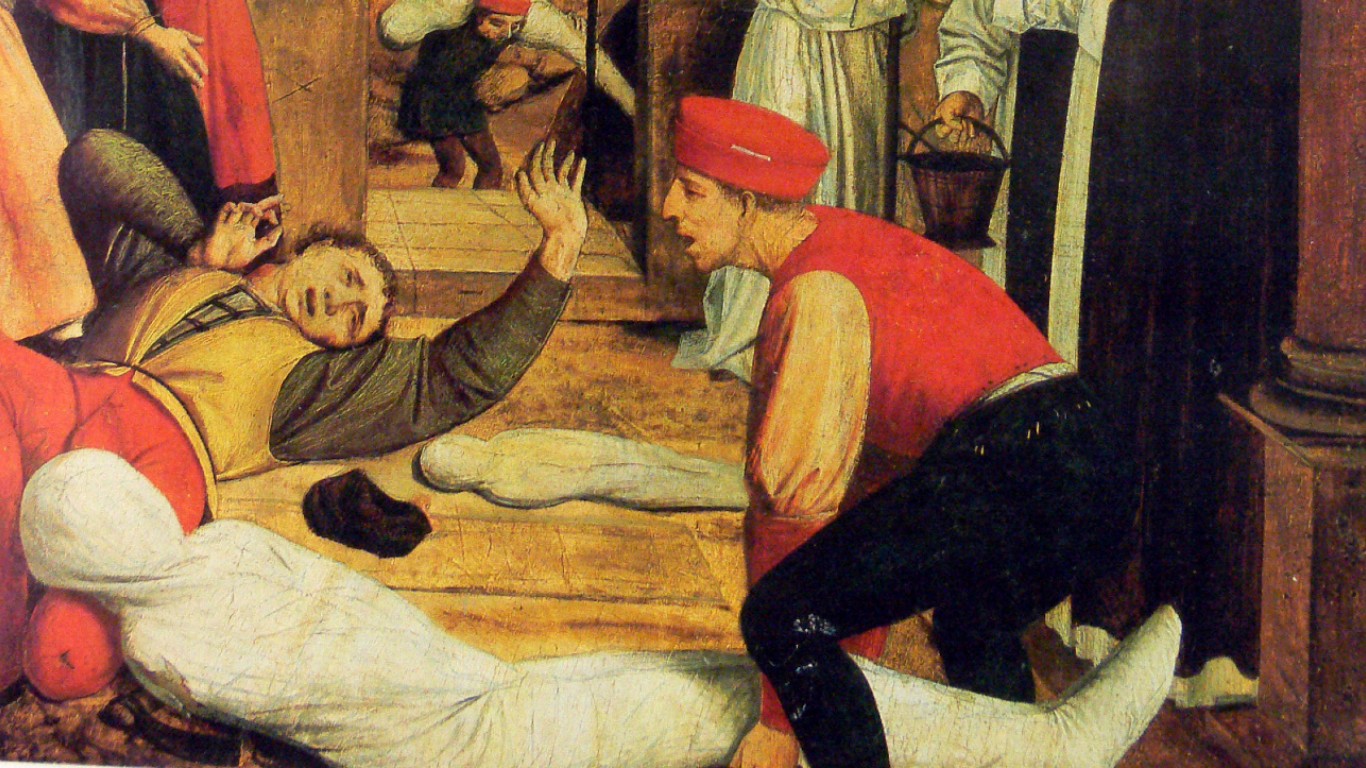
Istanbul, Turkey
> Tragedy: Plague
> When it happened: A.D. 541
> Population at the time: 500,000 to 1 million
Emperor Justinian’s attempt at restoring the glory of ancient Rome came to an end in A.D. 541, when a plague spread in the city of Constantinople — known today as Istanbul — and virtually destroyed the Byzantine Empire. The contagion was the first recorded reference to the flea-borne illness called the Black Death. As a densely populated port city, Constantinople was vulnerable to outbreaks. The disease would kill millions in Europe in one of the worst plagues in the history of humankind. The city’s geographic position astride Europe and Asia across the Bosphorus Strait was crucial in its comeback.
Today it is a tourist mecca. In the first five months of 2019, 5.42 million foreign tourists visited Istanbul, an 11% increase from the same period of the previous year. They went to attractions such as the Hagia Sophia Grand Mosque, the Blue Mosque, and the Beylerbeyi Palace.
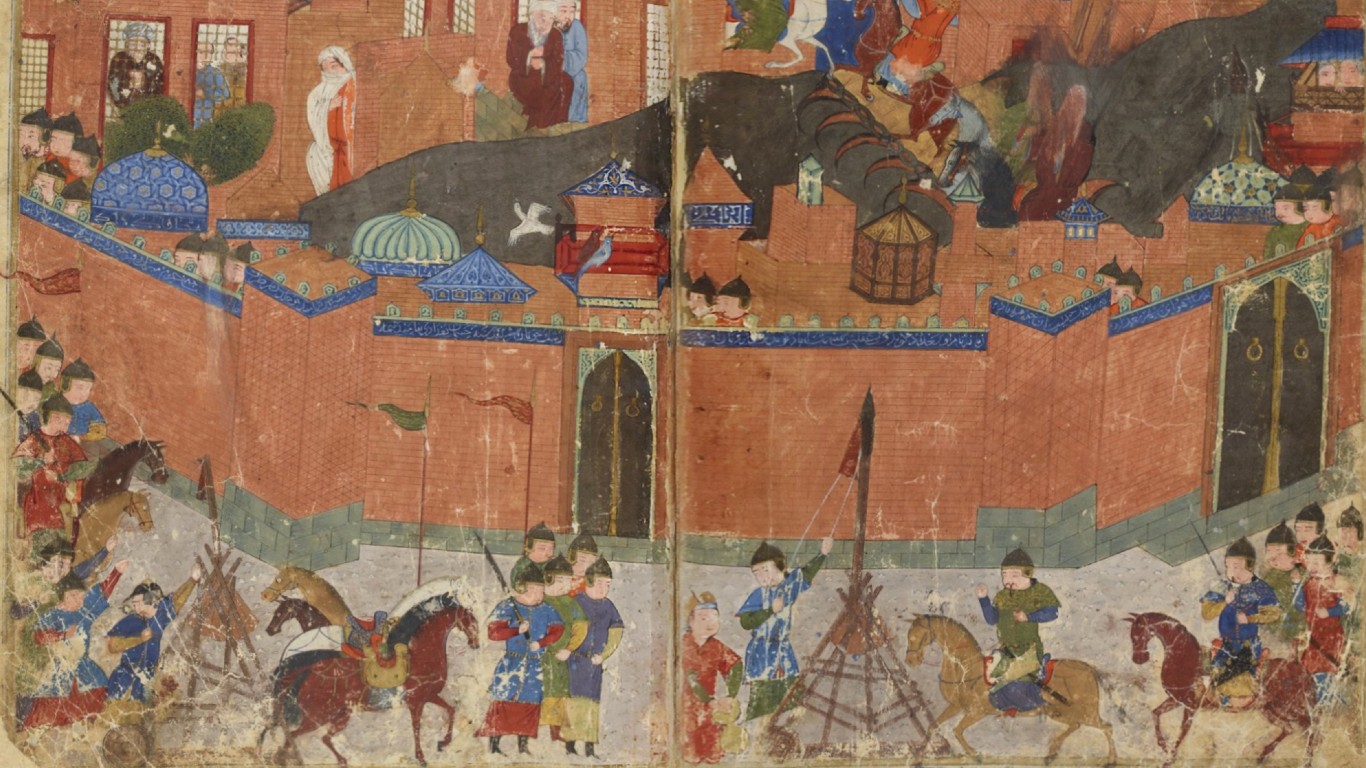
Baghdad, Iran
> Tragedy: Sacked by Mongols
> When it happened: 1258
> Population at the time: 1 million
The Siege of Baghdad, which at the time was the world’s largest and most prosperous city, lasted for about two weeks. Historians sometimes refer to the raid as one of the bloodiest days in human history. Many of the city’s 1 million residents were killed by the Mongol army. The sacking was effectively the beginning of the end of the Islamic Golden Age.
Until recently, Baghdad was a modern metropolis. The capital of Iraq, and one of the most populous cities in the Middle East — the city of 7.6 million — the population is estimated to grow to 10 million by 2035 — has been struggling since the Persian Gulf War of the early 1990s and the Iraq War beginning in 2003.
[in-text-ad-2]

London, England
> Tragedy: Fire
> When it happened: 1666
> Population at the time: 500,000
A fire that broke out in a bakery near London Bridge in early September in 1666 quickly grew into an inferno, stoked by high winds and the result of a prolonged dry summer. The fire raged for four days, wiping out 80% of London and destroying wooden houses and overcrowded, disease-plagued streets.
The 1667 Rebuilding Act was intended to eliminate risks that allowed the fire to spread, including forbidding the upper floors of houses to jut out over the floor below. All building materials were to be brick and stone, and the first fire hydrants were introduced. The city was rebuilt and would eventually become one of the world’s financial centers.

Lisbon, Portugal
> Tragedy: Earthquake, tsunami
> When it happened: 1755
> Population at the time: 275,000
The Great Lisbon Earthquake was several earthquakes that devastated Lisbon (along with several other cities on the Algarve coast) on Nov. 1, 1755. Seismologists estimate the tremor had a magnitude in the range 8.5-9.0 on the moment magnitude scale. The earthquake generated a tsunami with waves about 20 feet high. About 60,000 people, or about a fifth of the port city’s population, perished that day, and most of the city’s infrastructure was destroyed.
Today, Lisbon is a major tourist destination, known for its beaches as well as art scene. Portugal’s capital often lands on lists such as best cities in the world and best places for expats.
[in-text-ad]

Paris, France
> Tragedy: Cholera epidemic
> When it happened: 1832
> Population at the time: 650,000
A cholera epidemic swept through Paris for over six months starting in May of 1832, killing 19,000 people. The event prompted city planners to take steps to address the issue of public hygiene. They widened the streets and sidewalks, eradicated the warren of overcrowded slums, and created a drainage system.
The movement for better public hygiene was a key aspect of the planning of the city by renowned urban planner Baron Haussmann and the plan was crucial in shaping the city that we know today.
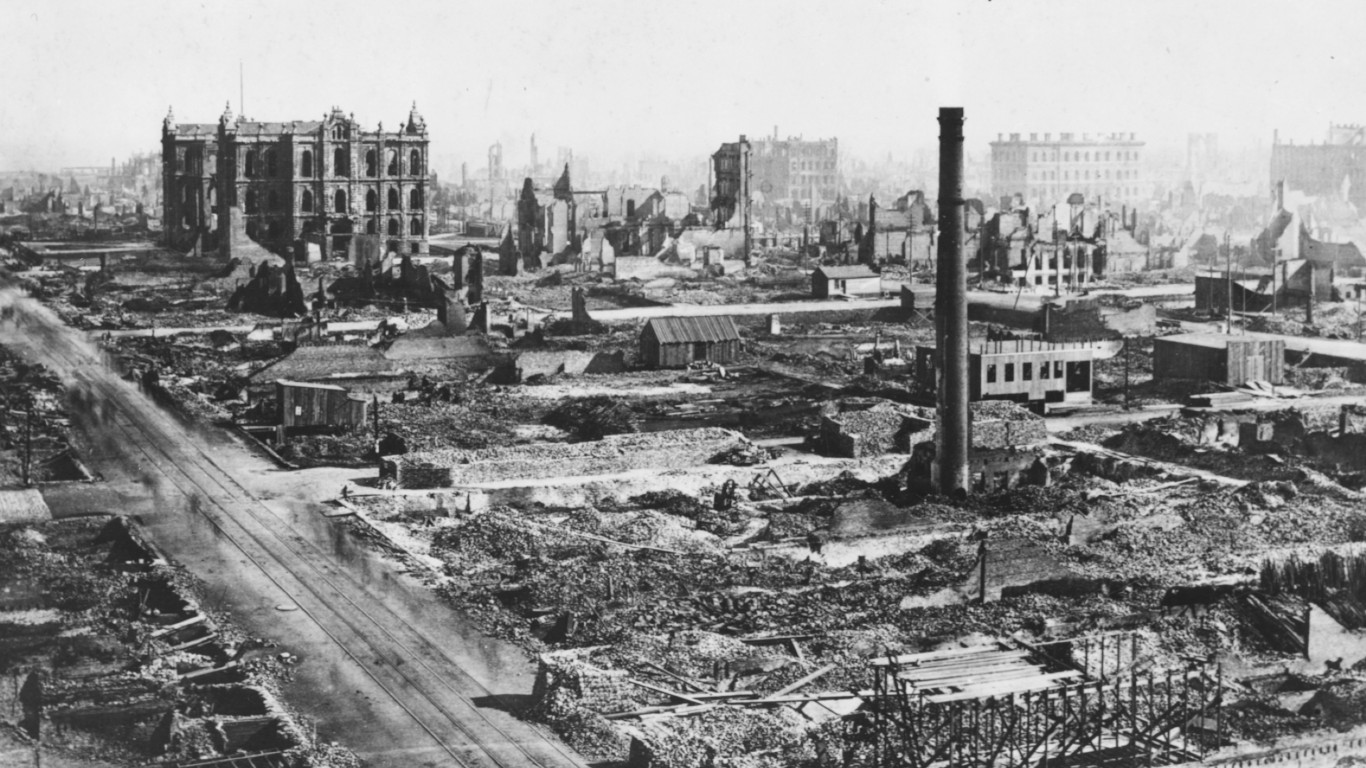
Chicago, Illinois
> Tragedy: Fire
> When it happened: 1871
> Population at the time: 324,000
The Great Chicago Fire of 1871 burned throughout the city for two days. Flames spread from a barn in the southwest side of Chicago and, carried by strong winds, they moved several miles to the business district, destroying more than 17,000 buildings and 73 miles of streets, killing 300 people, and displacing 90,000. Years of rebuilding followed, during which time the city became a new, urban center with big businesses moving in and innovatively designed buildings.
Today, Chicago is the third most populous city in the U.S. with a population of nearly 3 million people. The Windy City is an important cultural and arts destination, a major sports city. Also, Chicago often makes lists like best big cities to live in as rated by Conde Nast Traveler readers.

San Francisco, California
> Tragedy: Earthquake, fire
> When it happened: 1906
> Population at the time: 400,000
A 7.9 magnitude earthquake on April 18, 1906, shook San Francisco, igniting fires around the city that wiped out about 500 city blocks. The tragedy was amplified by the buildings that were constructed on reclaimed swampland and the use of unreinforced brick masonry.
In the aftermath, the city quickly cleared the debris and improved its water system. In its zeal to rebuild quickly, San Francisco shelved plans to create wide boulevards. Its charm and eccentricity make the city one of the biggest tourist destinations in the United States.
[in-text-ad-2]

Miami, Florida
> Tragedy: Hurricane
> When it happened: 1926
> Population at the time: 100,000
Miami, Florida, and the Gulf Coast in general, are no strangers to hurricanes. But the 1926 Category 4 storm has been described by the Weather Bureau as “probably the most destructive hurricane ever to strike the United States.” It first hit the Bahamas, moving on to hit Fort Lauderdale, Dania, Hollywood, Hallandale, and, most severely, Miami. The winds of up to 150 mph and storm surge of 10 feet caused the most property damage in U.S. history at the time.
Today, Miami has a population of about 470,000 people. The city is a major destination for people who want to escape cold winters in the North, eat authentic Cuban food, or party.

Madrid, Spain
> Tragedy: Spanish Civil War
> When it happened: 1937-1939
> Population at the time: 900,000
Planes flown by General Francisco Franco’s fascist forces and from Nazi Germany conducted bombing raids on Madrid during the Spanish Civil War beginning in August of 1936. Buildings such as the Palace of Moncloa — the residence of the Spanish prime minister — were destroyed during the siege but eventually reconstructed.
Spain has become the world’s second-most visited country after France, with tourism comprising nearly 12% of gross domestic product. In 2019, around 7.64 million international visitors came to Madrid, an increase of about 4.5 million more visits than in 2001.
[in-text-ad]
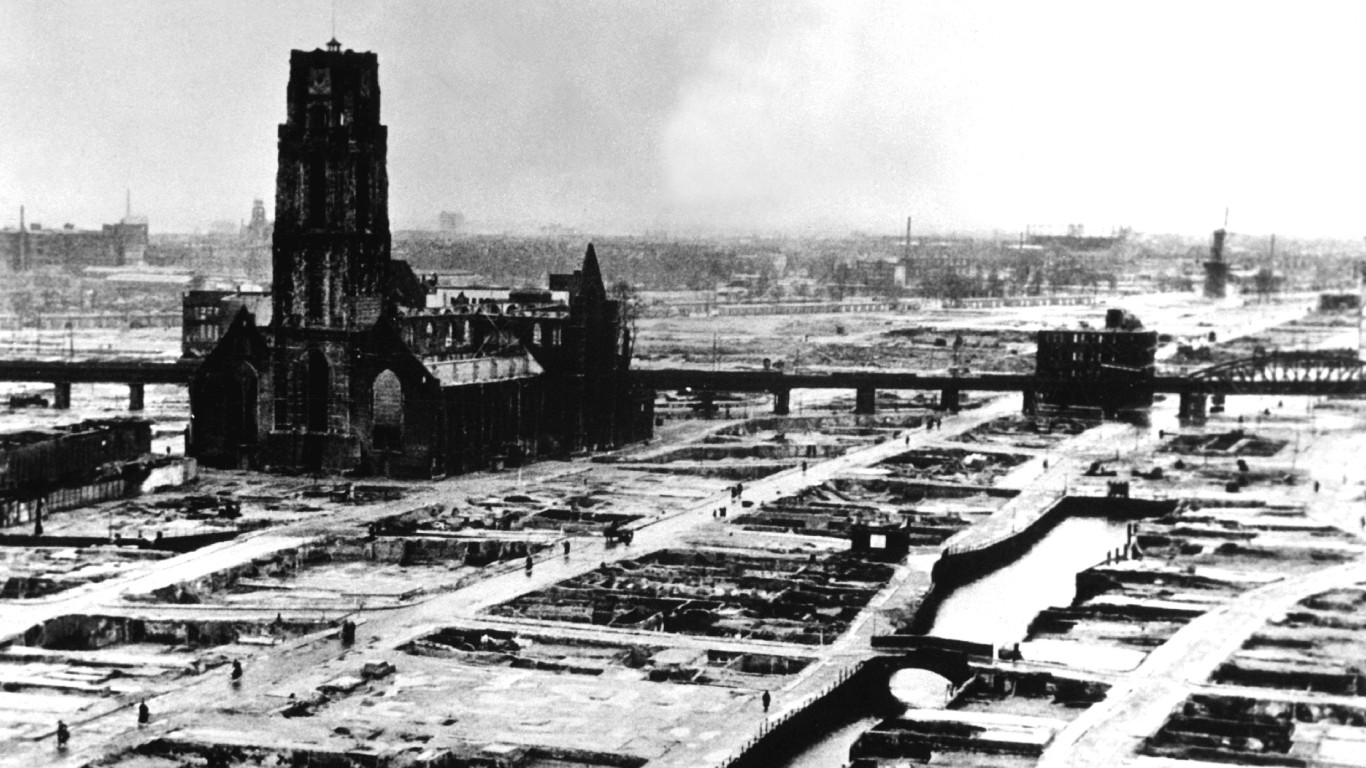
Rotterdam, Holland
> Tragedy: World War II
> When it happened: 1940
> Population at the time: 620,000
The 1940 German bombing of Rotterdam during World War II destroyed all but a few structures in the city. Nazi forces, which wanted to capture the port city because of its strategic location, bombed Rotterdam for a day, wiping out more than 25,000 buildings.
The city, which was basically rebuilt from scratch, used the chance to remodel in a way that fixed its previous problems of overcrowding and poverty-stricken neighborhoods. Today, Rotterdam is the Netherlands’ second most populous city and the biggest port city in Europe.
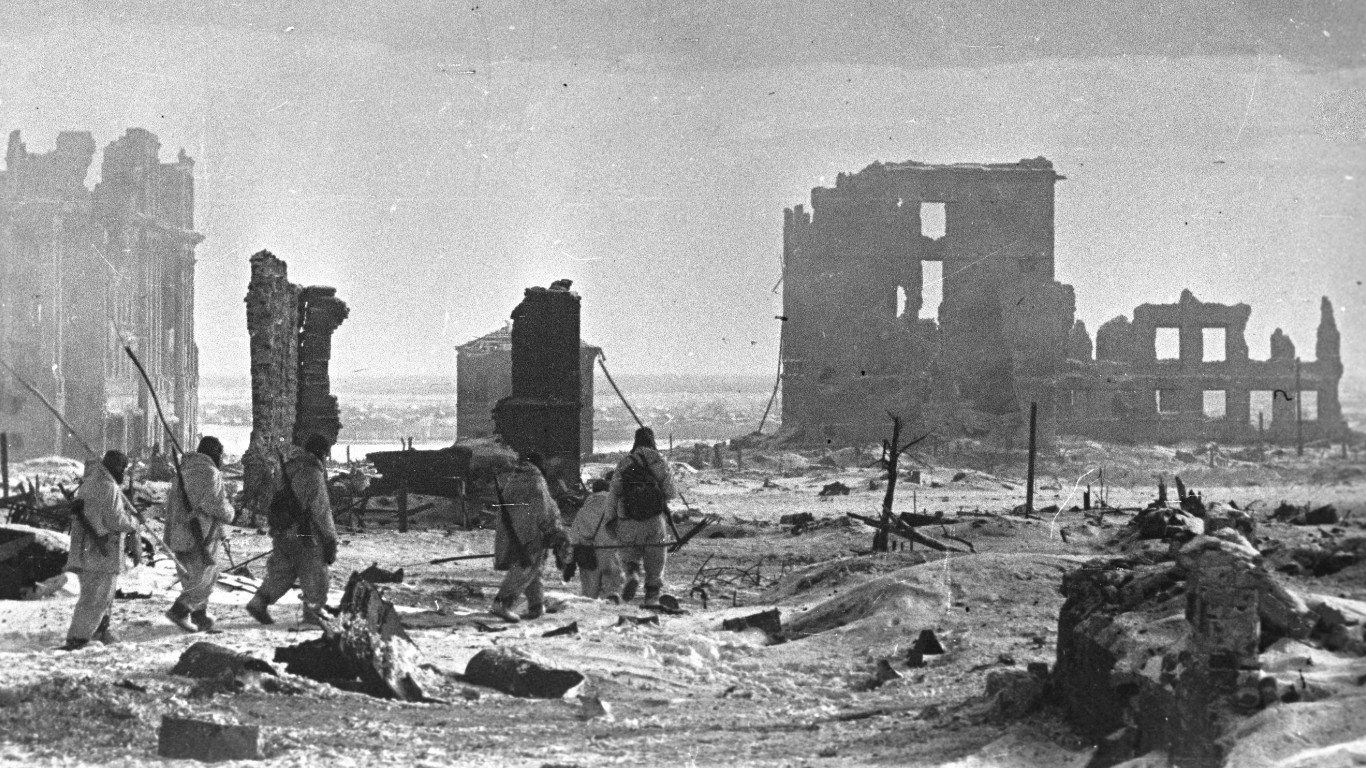
Volgograd (Stalingrad), Russia
> Tragedy: World War II
> When it happened: 1942-1943
> Population at the time: 850,000
Volgograd in Russia, formerly Stalingrad, was the site of WWII’s largest and most destructive battle. Hundreds of thousands of soldiers from the Soviet Union and Nazi Germany were killed. By the war’s end in 1945, only 1,500 people were left from a city whose population had numbered about 850,000.
The rebuilt city, including its famous Children’s Circle Dance Fountain and the statue The Motherland Calls, was reconstructed in a monumental style to salute the heroism of the Russian people.
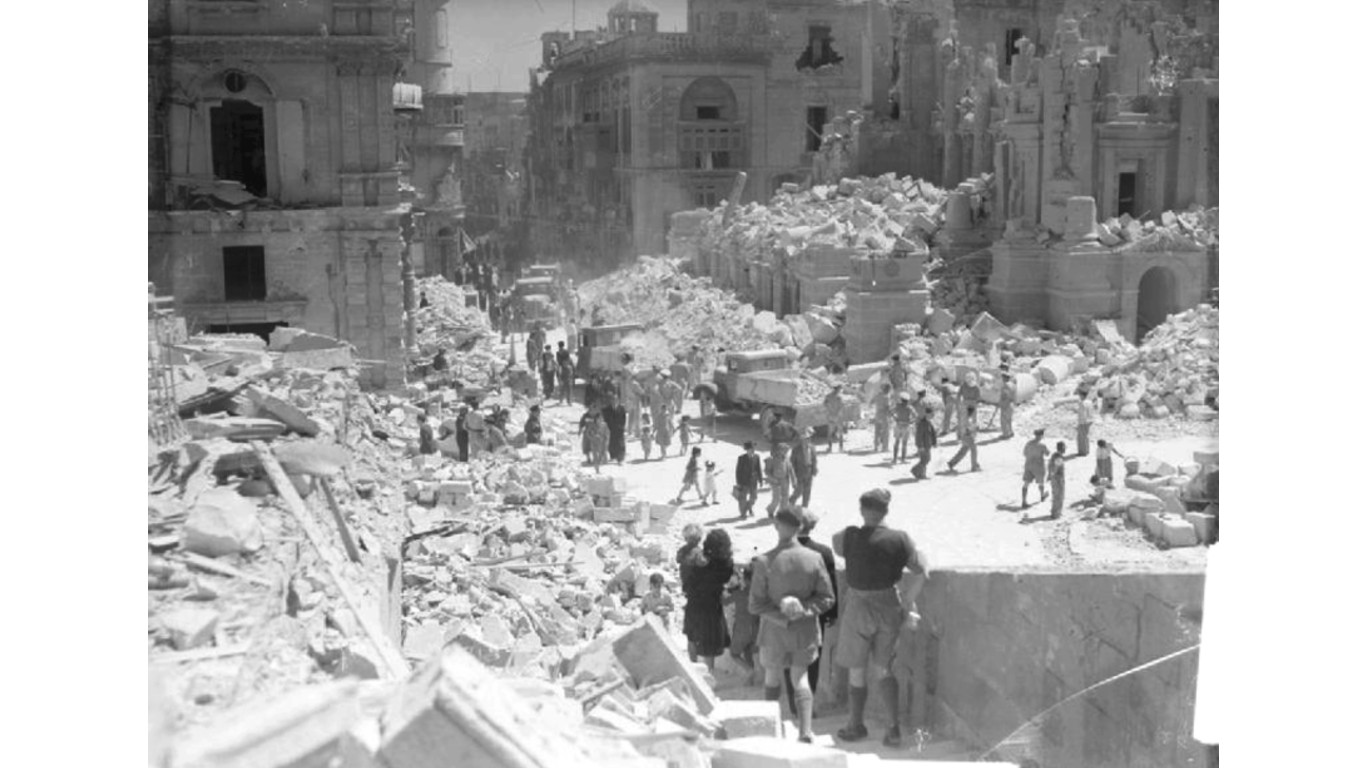
Valletta, Malta
> Tragedy: World War II
> When it happened: 1940-1942
> Population at the time: 23,000
When Italy bombed Malta in 1940, the strategically important island became the most bombed place on Earth. Italian bombers began their siege on the country by attacking Valletta and its harbors. The capital of Malta, then Britain’s strategic naval position in the Mediterranean, was the military and commercial center of the country, as well as the most densely populated city.
It took more than four decades for the city to fully recover. Today, the tiny, fortified capital is a World Heritage site because of its historical importance. It was the 2018 European Capital of Culture.
[in-text-ad-2]

Milan, Italy
> Tragedy: World War II
> When it happened: 1942-44
> Population at the time: 1.2 million
Milan, the second-most populous city in Italy, was a strategic target of Allied bombing during WWII because of its importance as an industrial and manufacturing center. The air raids destroyed many works of art and architecture. Leonardo da Vinci’s immortal painting “The Last Supper” as well as the famed Ciborium of St. Ambrose were spared from the destruction.
Milan began to get back on its feet in May 1946 with the reopening of the famed Teatro alla Scala. After the war, greater design freedom flourished in Milan with the construction of the medieval-influenced Torre Velasca; the Pirelli skyscraper, one of the tallest reinforced concrete buildings in the world; and the Padiglione d’arte Contemporanea, the contemporary art museum. Milan is also one of the world’s fashion centers.

San Juan, Argentina
> Tragedy: Earthquake
> When it happened: 1944
> Population at the time: 100,000
The city of San Juan, capital of the Andes Mountain Province of the same name suffered catastrophic damage from an earthquake that lasted less than a minute. It had an estimated magnitude of around 7.8 on the Richter scale. The death toll was estimated to be around 10,000, about a 10th of the area’s population at the time. It was the worst natural disaster in the country’s history.
San Juan is now one of Argentina’s most modern cities, with a population of around 120,000 people. Today, the city is best known for its wine.
[in-text-ad]
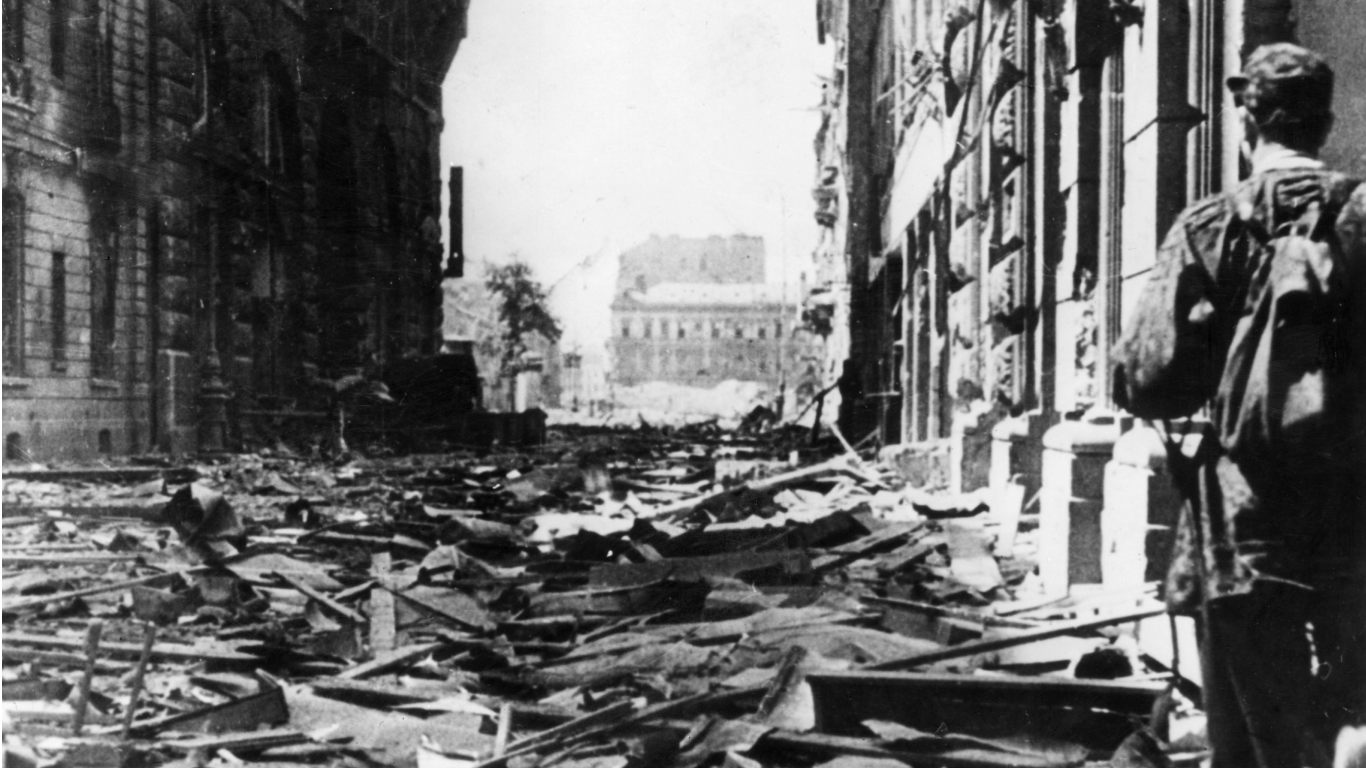
Warsaw, Poland
> Tragedy: World War II
> When it happened: 1939, 1944
> Population at the time: 1 million
The Polish capital of Warsaw suffered damage from German air raids at the start of WWII. The worst was still to come. As Nazi troops retreated across Poland in 1944, the Polish resistance movement initiated the Warsaw Uprising, which lasted for more than two months. The Germans crushed the revolt and in revenge razed virtually the entire city, destroying churches, palaces, and libraries.
The Poles carefully rebuilt the old town section of Warsaw using street maps from the 18th century. The old town section of Warsaw is now a UNESCO World Heritage site.
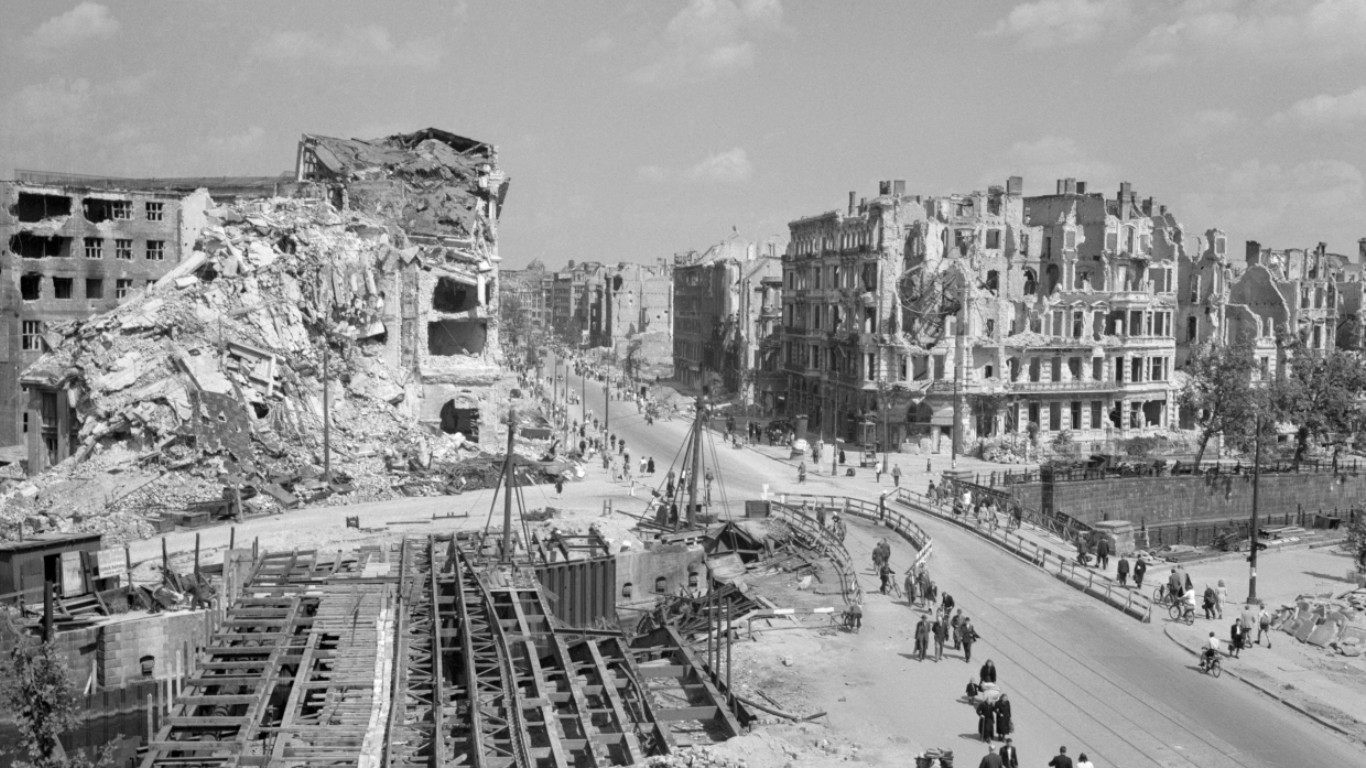
Berlin, Germany
> Tragedy: World War II
> When it happened: 1940-1945
> Population at the time: 4.3 million
About 80% of Berlin was reduced to rubble toward the end of WWII. The Soviet army fought with the Nazi forces street by street for two weeks to take control of the city, before Nazi Germany surrendered unconditionally. Over the course of the entire war, the German capital was hit by 67,607 tonnes of explosives.
Berlin, which rebuilt itself again as a unified city after the fall of the Berlin Wall in 1989, is now a cultural and economic power in Europe. The German capital is the largest city in Germany by population.
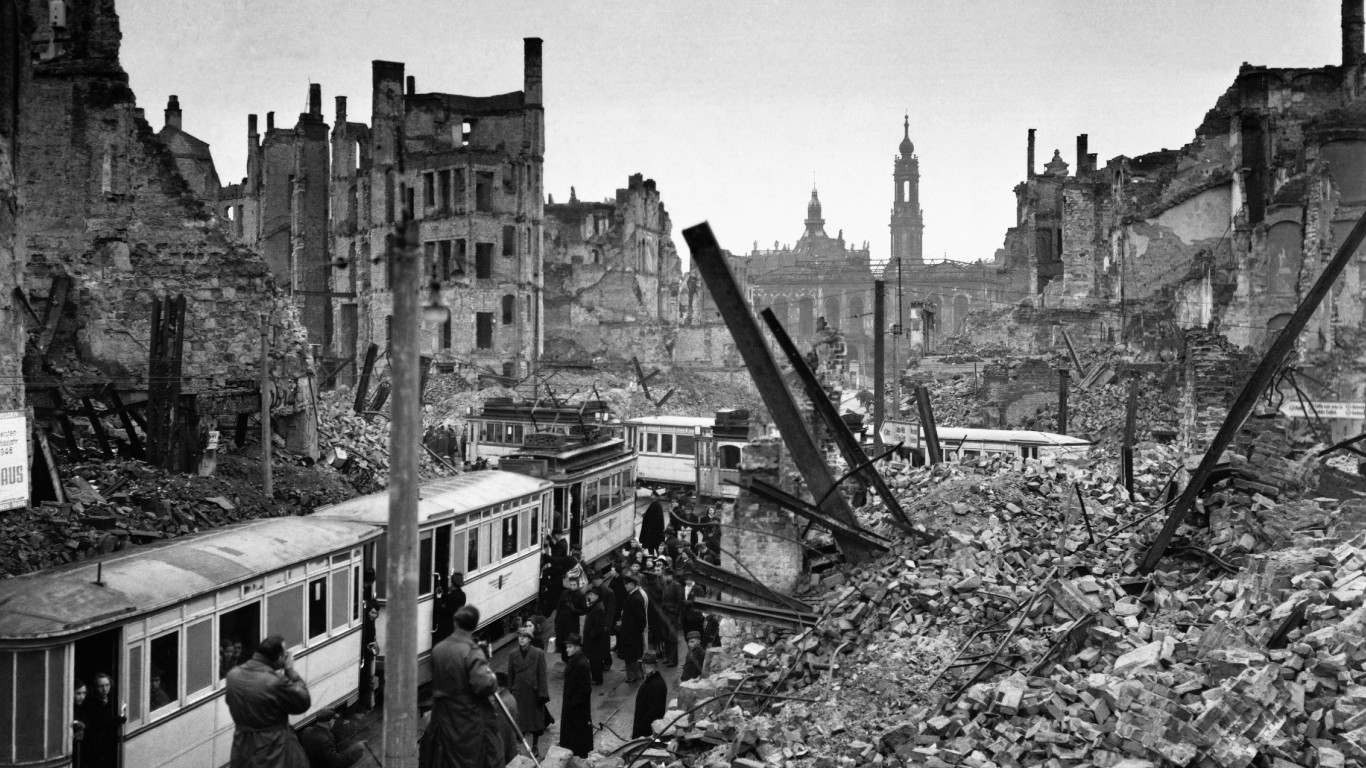
Dresden, Germany
> Tragedy: World War II
> When it happened: 1945
> Population at the time: 1.2 million
The firebombing of Dresden, Germany, by American and British bombers in February 1945, described in Kurt Vonnegut’s book “Slaughterhouse-Five,” was one of the most controversial decisions made by the Allies during WWII. About 25,000 people were killed. The raid devastated a city famous for its Baroque architecture and museums, earning it the moniker “the Florence of the Elbe.”
Cultural institutions damaged such as the Zwinger Palace and the Dresden State Opera House were reconstructed, as was its most famous structure, the Lutheran church Frauenkirche, a symbol of suffering that was completely restored in 2005. Most of the city was reconstructed with modern buildings.
[in-text-ad-2]

Manila, the Philippines
> Tragedy: World War II
> When it happened: 1945
> Population at the time: 673,000
The Allied forces fought for about a month in 1945 to get Manila back from Japanese forces, which had taken control of the city three years prior. Some historians describe it as “the biggest urban battle” in the Pacific war. Allied forces didn’t use airstrikes in order to save civilians — though about 100,000 of them were killed. Soldiers instead fought street by street to win the city. By the end of the siege, Manila was devastated.
Today, Manila is a densely populated bayside city and a center of the Philippines’ political and economic scene. Manila is also a bustling social and cultural hub.

Tokyo, Japan
> Tragedy: World War II
> When it happened: 1944-1945
> Population at the time: 6.4 million
Tokyo had gradually rebounded from the catastrophic Great Kanto Earthquake that destroyed the city and other Japanese cities in 1923. That progress would be wiped out by U.S. air raids during WWII. On March 9, 1945, U.S. warplanes dropped 2,000 tons of incendiary bombs on Japan’s largest city over a period of two days, unleashing the worst firestorm in history that killed between 80,000 and 130,000 Japanese civilians.
After the war, Japan built a more modern city, in contrast to the mostly wooden structures that were a feature of the capital. A pro-growth coalition government supported a building surge that included office and residential buildings, superhighways leading to Haneda International Airport, new subway lines, and a bullet train between Tokyo and Osaka. Tokyo has become one of the preeminent cities in the world in terms of economic and financial significance.
[in-text-ad]

Ho Chi Minh City (Saigon), Vietnam
> Tragedy: Vietnam War
> When it happened: 1968
> Population at the time: 2.5 million
Saigon (now Ho Chi Minh City) was the capital of South Vietnam before the nation was reunited in 1975, when the city fell to communist forces that ended the Vietnam War. Saigon was attacked by Viet Cong troops allied with North Vietnam during the Tet Offensive in January 1968, and heavy fighting also occurred in the Cholon section of the city that was home to ethnic Chinese. The U.S. embassy was also attacked.
With the war becoming a distant memory, tourists are flocking to Saigon to drink coffee — Vietnam is the world’s second-biggest producer of coffee after Brazil — and enjoy its signature noodle soup, pho.

Beirut, Lebanon
> Tragedy: Civil war, Israeli invasion
> When it happened: 1975-2000
> Population at the time: 1.5 million
Beirut had been called the “Paris of the Middle East,” owing to its sophistication and Lebanon’s legacy as a French colony. But both the Lebanese Civil War that began in 1975 and invasion of Lebanon by Israel in 1982 turned the city on the east coast of the Mediterranean Sea into a killing field.
The civil war ended in 1990, and Israel withdrew from Lebanon in 2000. Beirut has rebounded, attracting foreign investment, and its downtown boasts modern architecture and affluent residences. But among the costs of reconstruction have been the tearing down of historic buildings. There are also some concerns that the city lacks public services and that the government has not done enough to rebuild infrastructure. Beirut’s resilience is being put to the test following a massive blast in the port section of the city that killed 200 people.

Kobe, Japan
> Tragedy: Earthquake
> When it happened: 1995
> Population at the time: 1.5 million
In 1995, Kobe was hit by one of the strongest and deadliest earthquakes in the history of Japan, a country prone to earthquakes because it lies across three tectonic plates. The death toll is estimated to have been close to 6,400. Another 300,000 people, or a fifth of the population at the time, were left homeless. More than 240,000 houses were damaged or destroyed.
Today, Kobe has been completely rebuilt and has become a tourist attraction year-round due to its proximity to both the ocean and a mountain range. It’s famous for its Kobe beef, too. Along with the nearby cities of Osaka and Kyoto, Kobe is part of Japan’s second largest urban and industrial area.
[in-text-ad-2]

New York City, New York
> Tragedy: Terrorism, epidemics, fiscal crisis
> When it happened: 2001
> Population at the time: 8 million
There is much talk about the exodus from New York City due to the coronavirus pandemic. As more residents work remotely, they leave the densely-populated city for homes with more space and lower cost of living. The city has been through such a shift before — after the 9/11 terrorist attack, the worst on American soil. Many people then moved to New Jersey. But after a few months, the pace of departures slowed, eventually reversing.
New York has overcome other setbacks. The cholera epidemic in 1832 killed 3,515 out of a population of 250,000 (today’s equivalent would be more than 100,000). The HIV/AIDS epidemic in the ’80s killed more than 100,000 residents. The financial crisis of the 1970s, when the city was on the verge of bankruptcy, led to thousands of layoffs, a wage freeze, a subway price hike, and charging tuition at what was a free City University.
Retirement planning doesn’t have to feel overwhelming. The key is finding professional guidance—and we’ve made it easier than ever for you to connect with the right financial advisor for your unique needs.
Here’s how it works:
1️ Answer a Few Simple Questions
Tell us a bit about your goals and preferences—it only takes a few minutes!
2️ Get Your Top Advisor Matches
This tool matches you with qualified advisors who specialize in helping people like you achieve financial success.
3️ Choose Your Best Fit
Review their profiles, schedule an introductory meeting, and select the advisor who feels right for you.
Why wait? Start building the retirement you’ve always dreamed of. Click here to get started today!
Thank you for reading! Have some feedback for us?
Contact the 24/7 Wall St. editorial team.